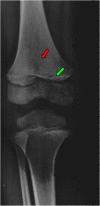Scurvy may occur even in children with no underlying risk factors: a case report
- PMID: 31973768
- PMCID: PMC6979388
- DOI: 10.1186/s13256-020-2341-z
Scurvy may occur even in children with no underlying risk factors: a case report
Abstract
Background: Since ancient times, scurvy has been considered one of the most fearsome nutritional deficiency diseases. In modern developed countries, this condition has become very rare and is only occasionally encountered, especially in the pediatric population. Underlying medical conditions, such as neuropsychiatric disorders, anorexia nervosa, celiac disease, Crohn disease, hemodialysis, and severe allergies to food products may enhance the risk of developing scurvy.
Case presentation: We report the case of an otherwise healthy 3-year-old white boy who developed scurvy due to a selective restrictive diet derived from his refusal to try new food. He presented to our clinic with asthenia and refusal to walk. During hospitalization he developed severe anemia and hematochezia. A diagnosis of scurvy was assessed on the basis of nutritional history, clinical features, radiographic findings, and laboratory findings. Supplementation of ascorbic acid enabled a prompt resolution of symptoms.
Conclusions: Scurvy is caused by vitamin C deficiency. Cutaneous bleeding, mucosal bleeding, and anemia represent typical manifestations of the disease. These symptoms are directly connected to ascorbic acid involvement in collagen biosynthesis. Some radiographic findings can be useful for the diagnosis. Treatment aims to normalize serum levels of vitamin C in order to counteract the deprivation symptoms. The present case report demonstrates that scurvy may sporadically occur in pediatric patients, even in individuals with no predisposing medical conditions and/or potential risk factors.
Keywords: Anemia; Ascorbic acid; Gingival bleeding; Hematochezia; Musculoskeletal pain; Petechial hemorrhages.
Conflict of interest statement
The authors declare that they have no competing interests.
Figures
References
Publication types
MeSH terms
Substances
LinkOut - more resources
Full Text Sources
Medical


